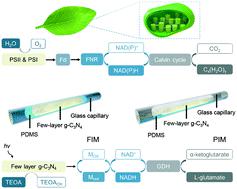Our official English website, www.x-mol.net, welcomes your
feedback! (Note: you will need to create a separate account there.)
A versatile optofluidic microreactor for artificial photosynthesis induced coenzyme regeneration and L-glutamate synthesis
Lab on a Chip ( IF 6.1 ) Pub Date : 2022-07-04 , DOI: 10.1039/d2lc00398h Ziyu Huang 1 , Lei Wang 1 , Chonghui Yang 1 , Jiaci Chen 1 , Gaozhen Zhao 1 , Xiaowen Huang 1
Lab on a Chip ( IF 6.1 ) Pub Date : 2022-07-04 , DOI: 10.1039/d2lc00398h Ziyu Huang 1 , Lei Wang 1 , Chonghui Yang 1 , Jiaci Chen 1 , Gaozhen Zhao 1 , Xiaowen Huang 1
Affiliation

|
With the rapid development of modern society, the energy crisis has become a global concern. Solar energy is a good replacement because it is green, unlimited and environment-friendly. Inspired by natural photosynthesis, artificial photosynthesis was developed to convert solar energy to chemical energy by a photocatalyst system. For better utilizing solar energy and improving the conversion efficiency, the design of photoreactors is crucial for the improvement of photocatalysis efficiency. However, most of the reported microreactors hardly satisfy the demands for low cost, easy fabrication, high transparency, being evaporation-proof, ease of scaling up, high surface-to-volume ratio, and photocatalyst immobilization. In this paper, we developed a facile method to build a fully immobilized microreactor (FIM) and a controllable partially immobilized microreactor (PIM), both of which satisfy all the demands mentioned above. In the FIM, the regeneration rate of a coenzyme (nicotinamide adenine dinucleotide, NADH) reached 82.20% in 40 min. Considering the NADH regeneration rate per unit/coating angle of photocatalysts in circular microreactors, the PIM performed much better than the FIM, proving that our partial coating method is a significant and useful improvement. Also, the bioactivity of NADH toward enzyme catalysis was demonstrated by glutamate dehydrogenase-catalyzed synthesis of L-glutamate, and the conversion of α-ketoglutarate reached 99.92%. To test the practicality of the microreactor in a real environment, we performed a test under solar light, achieving a good result of 74.92% in 60 min. Thus, this efficient and versatile microfluidic platform may have good potential for photocatalytic synthesis of versatile valuable products in the future.
中文翻译:

用于人工光合作用诱导辅酶再生和 L-谷氨酸合成的多功能光流控微反应器
随着现代社会的快速发展,能源危机已成为全球关注的焦点。太阳能是一个很好的替代品,因为它是绿色的、无限的和环境友好的。受自然光合作用的启发,开发了人工光合作用,通过光催化系统将太阳能转化为化学能。为了更好地利用太阳能并提高转化效率,光反应器的设计对于提高光催化效率至关重要。然而,大多数报道的微反应器很难满足低成本、易于制造、高透明度、防蒸发、易于放大、高表面积与体积比和光催化剂固定化的要求。在本文中,我们开发了一种简便的方法来构建完全固定化微反应器(FIM)和可控部分固定化微反应器(PIM),两者都满足上述所有要求。在 FIM 中,辅酶(烟酰胺腺嘌呤二核苷酸,NADH)的再生率在 40 分钟内达到 82.20%。考虑到圆形微反应器中光催化剂单位/涂覆角的 NADH 再生率,PIM 的性能比 FIM 好得多,证明我们的部分涂覆方法是一个重要且有用的改进。此外,NADH 对酶催化的生物活性通过谷氨酸脱氢酶催化合成 考虑到圆形微反应器中光催化剂单位/涂覆角的 NADH 再生率,PIM 的性能比 FIM 好得多,证明我们的部分涂覆方法是一个重要且有用的改进。此外,NADH 对酶催化的生物活性通过谷氨酸脱氢酶催化合成 考虑到圆形微反应器中光催化剂单位/涂覆角的 NADH 再生率,PIM 的性能比 FIM 好得多,证明我们的部分涂覆方法是一个重要且有用的改进。此外,NADH 对酶催化的生物活性通过谷氨酸脱氢酶催化合成L-谷氨酸和α-酮戊二酸的转化率达到99.92%。为了在真实环境中测试微反应器的实用性,我们在太阳光下进行了测试,在 60 分钟内取得了 74.92% 的良好结果。因此,这种高效且多功能的微流控平台在未来可能具有用于光催化合成多功能有价值产品的良好潜力。
更新日期:2022-07-04
中文翻译:

用于人工光合作用诱导辅酶再生和 L-谷氨酸合成的多功能光流控微反应器
随着现代社会的快速发展,能源危机已成为全球关注的焦点。太阳能是一个很好的替代品,因为它是绿色的、无限的和环境友好的。受自然光合作用的启发,开发了人工光合作用,通过光催化系统将太阳能转化为化学能。为了更好地利用太阳能并提高转化效率,光反应器的设计对于提高光催化效率至关重要。然而,大多数报道的微反应器很难满足低成本、易于制造、高透明度、防蒸发、易于放大、高表面积与体积比和光催化剂固定化的要求。在本文中,我们开发了一种简便的方法来构建完全固定化微反应器(FIM)和可控部分固定化微反应器(PIM),两者都满足上述所有要求。在 FIM 中,辅酶(烟酰胺腺嘌呤二核苷酸,NADH)的再生率在 40 分钟内达到 82.20%。考虑到圆形微反应器中光催化剂单位/涂覆角的 NADH 再生率,PIM 的性能比 FIM 好得多,证明我们的部分涂覆方法是一个重要且有用的改进。此外,NADH 对酶催化的生物活性通过谷氨酸脱氢酶催化合成 考虑到圆形微反应器中光催化剂单位/涂覆角的 NADH 再生率,PIM 的性能比 FIM 好得多,证明我们的部分涂覆方法是一个重要且有用的改进。此外,NADH 对酶催化的生物活性通过谷氨酸脱氢酶催化合成 考虑到圆形微反应器中光催化剂单位/涂覆角的 NADH 再生率,PIM 的性能比 FIM 好得多,证明我们的部分涂覆方法是一个重要且有用的改进。此外,NADH 对酶催化的生物活性通过谷氨酸脱氢酶催化合成L-谷氨酸和α-酮戊二酸的转化率达到99.92%。为了在真实环境中测试微反应器的实用性,我们在太阳光下进行了测试,在 60 分钟内取得了 74.92% 的良好结果。因此,这种高效且多功能的微流控平台在未来可能具有用于光催化合成多功能有价值产品的良好潜力。











































 京公网安备 11010802027423号
京公网安备 11010802027423号